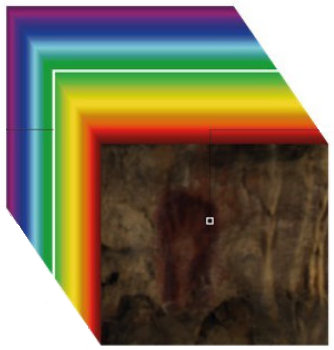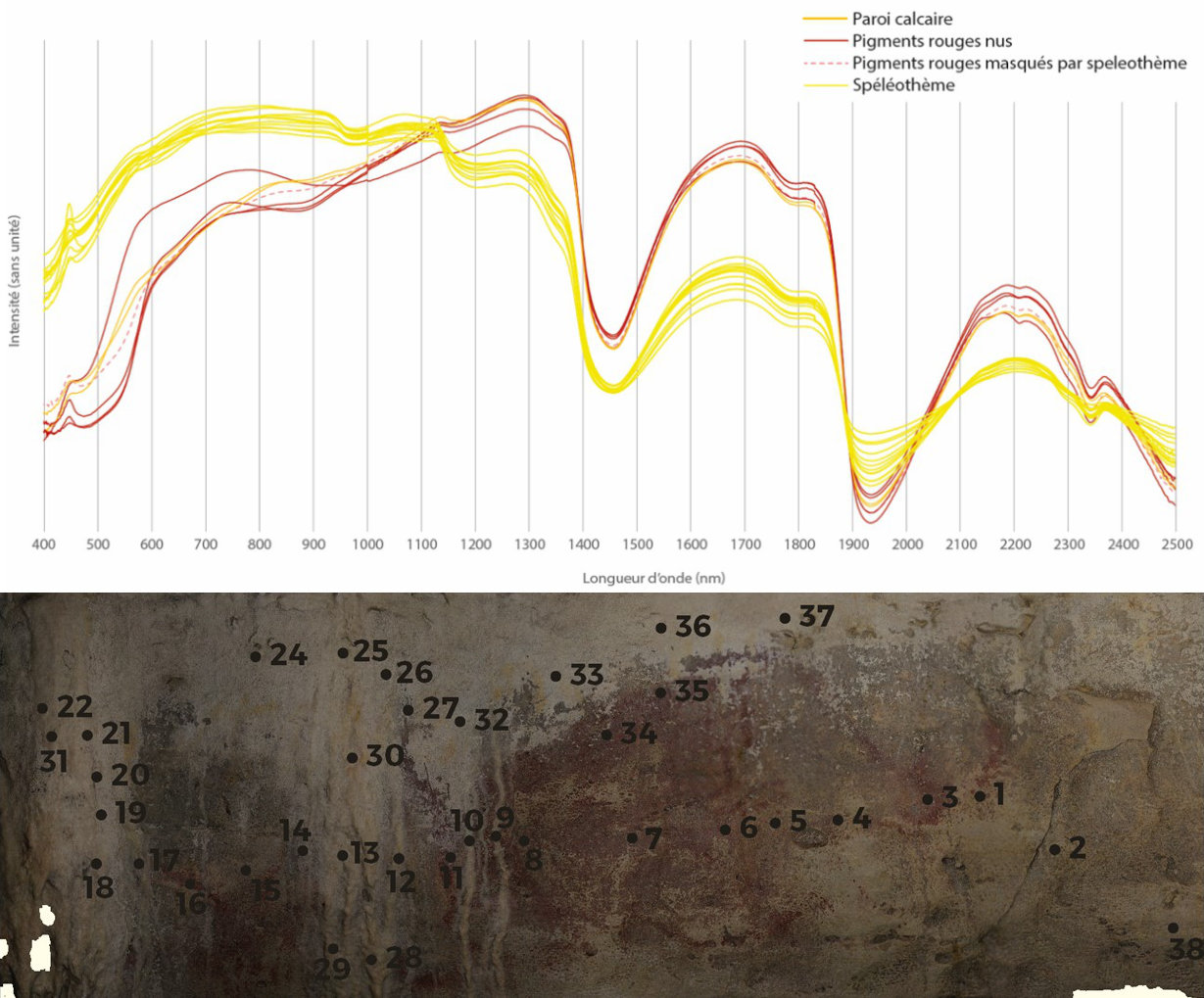
Characterization of limestone walls by hyperspectral imagery and in situ chemical analysis: applications to the study of built heritage and rock art
Started in september 2022
Funding : Cifre grant / Ingen
Supervisor: Fabrice Monna (Artehis) ; co-supervisor: Christophe Durlet (Biogéosciences) ; co-supervisor: Chloé Morales (Ingen)
Abstract

Limestone rocks surfaces, forming natural walls (caves, shelters, cliffs) or artificial (buildings, structures, steles, sculptures), are often covered by thin mineral or organic layers. Whether voluntary (pigments, paints) or involuntary (soot, carbonate, sulfate, oxalate mineralization, dust, microbial encrustations…), these films are commonly studied for natural and cultural heritage documentation and preservation. For a few years, visualizing and characterizing these various layers are improved by a new tool, developed in a very significant way: hyperspectral cameras. They offer real perspectives for remote mapping of these various films. However, collected hyperspectral signal is always very complex and influenced by multiple parameters. Physical and chemical proxy changes from one context to another. Thus, information must be sought in a specific spectral range and mineralogical, biological and chemical analysis provide calibration elements. Another focal point of this thesis is the processing of the large mass of data collected by hyperspectral analyses. In order to simplify the processing of hyperspectral data, and to make it feasible in the field, in the wake of the acquisition of spectra, a machine-learning approach (notably by neural networks), already engaged by the supervising team, is considered.
The research works are carried out by a Cifre agreement between the mixt research units (CNRS / University of Burgundy) Artehis and Biogéosciences and the company Ingen (Innovations Geosciences). The industrial purpose is the development of signal processing, including spectral unmixing, in order to apply it to the mapping of mineralogical and chemical phases that make up a natural or artificial rocky surface.
Keywords
hyperspectral imagery ; heritage documentation and preservation ; carbonates ; rock art
- titre:
- Caractérisation des parois calcaires par analyses hyperspectrales et chimiques in situ : applications à l’étude du patrimoine bâti et des parois de cavités ornées
- date_de_debut_these:
- septembre 2022
- nom:
- Jal
- date_de_debut_these_numerique:
- 202209
- kc_data:
- a:8:{i:0;s:0:"";s:4:"mode";s:0:"";s:3:"css";s:0:"";s:9:"max_width";s:0:"";s:7:"classes";s:0:"";s:9:"thumbnail";s:0:"";s:9:"collapsed";s:0:"";s:9:"optimized";s:0:"";}
- kc_raw_content:
 Characterization of limestone walls by hyperspectral imagery and in situ chemical analysis: applications to the study of built heritage and rock art
Characterization of limestone walls by hyperspectral imagery and in situ chemical analysis: applications to the study of built heritage and rock artStarted in september 2022
Funding : Cifre grant / Ingen
Supervisor: Fabrice Monna (Artehis) ; co-supervisor: Christophe Durlet (Biogéosciences) ; co-supervisor: Chloé Morales (Ingen)
Abstract
 Limestone rocks surfaces, forming natural walls (caves, shelters, cliffs) or artificial (buildings, structures, steles, sculptures), are often covered by thin mineral or organic layers. Whether voluntary (pigments, paints) or involuntary (soot, carbonate, sulfate, oxalate mineralization, dust, microbial encrustations...), these films are commonly studied for natural and cultural heritage documentation and preservation. For a few years, visualizing and characterizing these various layers are improved by a new tool, developed in a very significant way: hyperspectral cameras. They offer real perspectives for remote mapping of these various films. However, collected hyperspectral signal is always very complex and influenced by multiple parameters. Physical and chemical proxy changes from one context to another. Thus, information must be sought in a specific spectral range and mineralogical, biological and chemical analysis provide calibration elements. Another focal point of this thesis is the processing of the large mass of data collected by hyperspectral analyses. In order to simplify the processing of hyperspectral data, and to make it feasible in the field, in the wake of the acquisition of spectra, a machine-learning approach (notably by neural networks), already engaged by the supervising team, is considered.
Limestone rocks surfaces, forming natural walls (caves, shelters, cliffs) or artificial (buildings, structures, steles, sculptures), are often covered by thin mineral or organic layers. Whether voluntary (pigments, paints) or involuntary (soot, carbonate, sulfate, oxalate mineralization, dust, microbial encrustations...), these films are commonly studied for natural and cultural heritage documentation and preservation. For a few years, visualizing and characterizing these various layers are improved by a new tool, developed in a very significant way: hyperspectral cameras. They offer real perspectives for remote mapping of these various films. However, collected hyperspectral signal is always very complex and influenced by multiple parameters. Physical and chemical proxy changes from one context to another. Thus, information must be sought in a specific spectral range and mineralogical, biological and chemical analysis provide calibration elements. Another focal point of this thesis is the processing of the large mass of data collected by hyperspectral analyses. In order to simplify the processing of hyperspectral data, and to make it feasible in the field, in the wake of the acquisition of spectra, a machine-learning approach (notably by neural networks), already engaged by the supervising team, is considered.The research works are carried out by a Cifre agreement between the mixt research units (CNRS / University of Burgundy) Artehis and Biogéosciences and the company Ingen (Innovations Geosciences). The industrial purpose is the development of signal processing, including spectral unmixing, in order to apply it to the mapping of mineralogical and chemical phases that make up a natural or artificial rocky surface.
Keywords
hyperspectral imagery ; heritage documentation and preservation ; carbonates ; rock art
